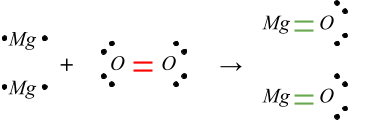Hope Arnett
AP Chemistry 🧪
269 resourcesSee Units
What Are Chemical Equations?
Chemical equations show the products that the combination of reactants yield, but the equation doesn’t show how the reactants form those products. What we don’t see are the underlying chemical and physical changes that allow molecules to rearrange to change properties or create new substances.
Chemical Changes
Generally, chemical changes involve intramolecular (literally meaning “inside molecule”) bonds. This includes breaking and/or forming bonds between elements. Let’s look at a chemical reaction using Lewis Dot Diagrams to visualize it.

The synthesis reaction above shows an interaction between magnesium and oxygen. The bonds that are broken are red, and the bonds formed are green. Here, we can see that the oxygen’s covalent bonds had to break, and then new ionic bonds formed between the magnesium and oxygen.
Physical Changes
Physical changes are usually intermolecular changes (literally meaning “between molecules”), such as phase changes. Some examples are freezing water🧊 and cutting paper✂️📄.
The ice’s molecules maintain the same atomic structure (H2O), but more hydrogen bonds between each water molecule are formed. Conversely, the paper’s molecules keep the same atomic structure, but the interaction between the paper molecules are broken.
However, some reactions can go either way. For example, the reaction between salt and water involves breaking the bonds between ions, but it also creates ion-dipole interactions between the water and ions.
Review Activity
Name whether each scenario describes a chemical or physical change.
- Burning a match🔥
- Iron rusting over time🚲
- Mixing two powders🥣
Answers
- Burning a match is a chemical change
- Iron rusting is a chemical change
- Mixing two powders is a physical change
🎥 Watch: AP Chemistry - Physical and Chemical Changes (Intro to Chemical Reactions)
Browse Study Guides By Unit
⚛️Unit 1 – Atomic Structure & Properties
🤓Unit 2 – Molecular & Ionic Bonding
🌀Unit 3 – Intermolecular Forces & Properties
🧪Unit 4 – Chemical Reactions
👟Unit 5 – Kinetics
🔥Unit 6 – Thermodynamics
⚖️Unit 7 – Equilibrium
🍊Unit 8 – Acids & Bases
🔋Unit 9 – Applications of Thermodynamics
✏️Frequently Asked Questions
✍️Free Response Questions
🧐Multiple Choice Questions
📆Big Reviews: Finals & Exam Prep

Fiveable
Resources
© 2023 Fiveable Inc. All rights reserved.